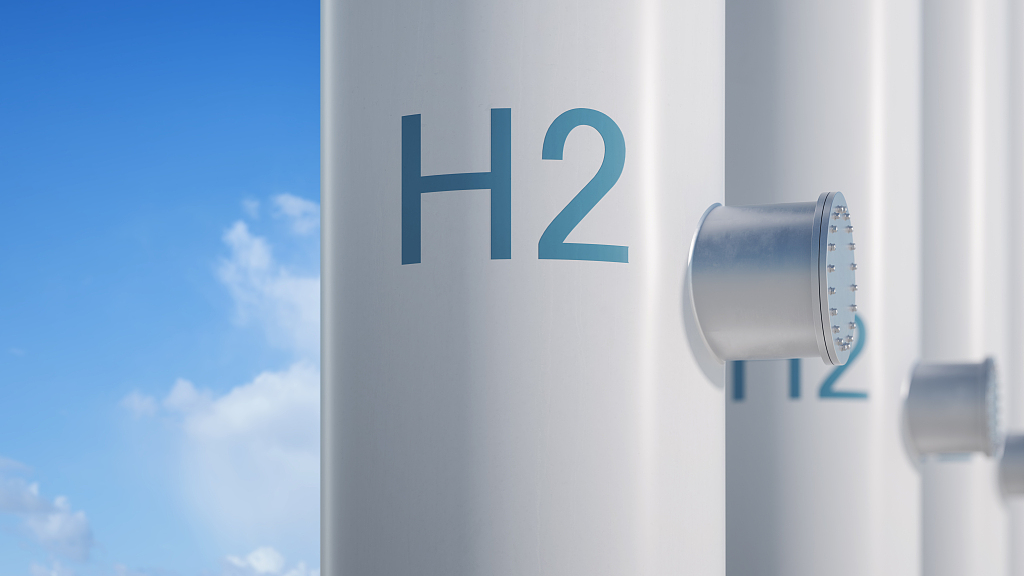
An image of hydrogen storage tubes. /CFP
An image of hydrogen storage tubes. /CFP
Renewable energies are receiving increasing global attention as nations reach agreements on combating climate change. In the meantime, as Russia and Ukraine remain in conflict, concerns about over-dependence on traditional energies are getting more obvious. Green hydrogen, as a clean energy alternative to fossil fuels, has caused more buzz than ever.
What is green hydrogen? A color-code system is commonly used to refer to different hydrogen production methods. Green hydrogen is produced through electrolysis of water using renewable energy, while grey hydrogen is produced through steaming using fossil fuels.
For years, a key obstacle to green hydrogen's widespread adoption has been its higher cost as opposed to grey hydrogen. However, now as global oil prices have skyrocketed, experts believe that the price of green hydrogen is now comparable to grey hydrogen.
Moreover, costs of green hydrogen are expected to continue to fall. Joe Buetzler, Asia-Pacific (APAC) CFO of global green hydrogen giant Linde Engineering, has predicted that producing green hydrogen will become even cheaper in the future. The costs of renewable energies keep dropping thanks to China's massive production of solar panels and more research and development is devoted to low-carbon hydrogen technology. These could herald declines in green hydrogen prices.
However, Richard Chahine, emeritus professor and co-founder of Hydrogen Research Institute at University of Quebec, is very cautious and said there is still a long way to go. "To achieve zero CO2 emissions by 2050, we should see an increase from 8 million to 80 million tons of green hydrogen production," Chahine said. Green hydrogen enjoys a pricing advantage now, and governments and companies should expedite the pace of green hydrogen transition.

CGTN host Guan Xin (L) talks to Richard Chahine, emeritus professor and co-founder, Hydrogen Research Institute; LEO Yang, general manager and executive director of CIMC Enric; and Joe Buetzler, executive director of Plant Lifecycle Solutions & CFO APAC, Linde Engineering. /CGTN
CGTN host Guan Xin (L) talks to Richard Chahine, emeritus professor and co-founder, Hydrogen Research Institute; LEO Yang, general manager and executive director of CIMC Enric; and Joe Buetzler, executive director of Plant Lifecycle Solutions & CFO APAC, Linde Engineering. /CGTN
Hyped-up hydrogen market
The appetite of governments around the world for adopting hydrogen to reduce carbon emissions is growing. According to the Hydrogen Council, over 30 nations released their hydrogen-specific roadmaps in 2021. However, those ambitious goals and plans are still very much just on paper.
The amount of money flowing into the hydrogen industry is far from enough. Currently, governments have committed only $37 billion to hydrogen, compared to $300 million from the private sector.
Chahine told CGTN that producing green hydrogen requires a significant initial investment.
"To get green electricity for making green hydrogen, we have to invest a lot of money in wind and solar electricity generation. Numbers are huge like $1,200 billion," said Chahine. He stressed that the current roadmaps for green hydrogen development are nice, but the industry needs capital to execute them.
China lays out hydrogen development roadmap
China places a high value on hydrogen as it strives to reach carbon neutrality by 2060. The National Development and Reform Commission issued the country's first long-term hydrogen plan on March 23, mapping out the development of its green hydrogen energy through 2035. China aims to establish an ecosystem of diverse green hydrogen applications including transportation and energy storage. Green hydrogen's portion of overall energy consumption is forecasted to expand dramatically, assisting China's clean energy transition.
The Beijing Winter Olympics and Paralympics, for example, featured a high number of hydrogen vehicles and refilling stations, making it the world's largest demonstration of hydrogen fuel cell vehicle usage. "When we use hydrogen for fuel cell vehicles, the energy conversion rate can be enhanced by up to 60 percent," Leo Yang, General Manager of CIMC Enric, said. CIMC Enric was a major supplier of hydrogen devices for the Beijing Winter Olympics.
Yang also introduced CIMC Enric's partnership with An Steel to change the traditional diesel oil truck into close to 5,000 hydrogen trucks.
"By achieving this, we will be able to save half a million tons of carbon emissions a year," Yang said.

